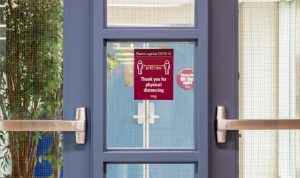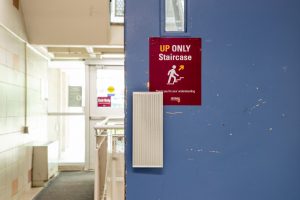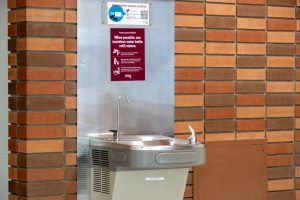That arrow on the floor is a good sign

Photos by Georgia Kirkos
Single-user washrooms. Single-user elevators. One-way hallways and staircases. And, of course, no hanging out.
McMaster’s campus looks very different for the small number of people beginning to increase research activity this week.

In the two weeks since Ontario’s government announced new guidelines for research activities, people from areas across campus have been working together on an intensive push to ensure that anyone approved to return for research is safely able to follow public health protocols.
“There’s understandably a strong desire to get back up and running, and our job is to support them as they do it,” says Debbie Martin, Associate Vice-President and Chief Facilities Officer, and co-chair of the university’s Return to Work Operations committee.
“We’re thinking about how to get people to their labs while ensuring they’re safe from end to end, from the moment they park their car to when they get back to it, and all stops in between.”
Faculties and departments have offered help and insights into how people move through buildings and labs, Martin says.
New measures include very frequent deep cleaning, clear wayfinding signage and accessibility measures, clear and highly visible signage to remind people to maintain a safe distance, reminders on using shared or high-touch spaces like hallways, staircases, washrooms, elevators and doors, and changes to parking.

“Ideally, we want people to park as close as they can to the building they need. Come in, do what you need to do and go home,” Martin says.
To help with these safety measures, the committee has developed a signage package that is available for labs to order online.
There are very limited options available for food services, amenities and shared spaces on campus.
Here are some of the measures in place:
- Most buildings are locked and secured. Many require swipe card access to enter.
- Hallways arrows on the floor indicate which direction to move in. Even corridors that are wide enough to accommodate two-way movement will have arrows to help maintain safe distancing.
- Staircases are similarly marked to indicate whether they’re for travelling up, down or wide enough for both.
- Building doors are marked as entrances or exits, so people don’t have to pass one another going in and out.
- Washrooms are now for use by one person at a time, regardless of their normal occupancy.
- The buildings with a focus on research have been thoroughly deep cleaned.
- High-touch spots like washrooms, stair rails, elevator buttons, entrance or exit push bars will continue to be cleaned throughout the day.
- Custodial staff will clean labs more frequently, and Facilities is supplying labs with cleaning supplies to wipe things down as research staff rotates through them between cleanings.
- Masks: Public Health recommends wearing non-medical masks when physical distancing can’t be achieved or counted upon.
Health and Safety has developed a range of safety protocols, information and advice for anyone approved to work on campus.


